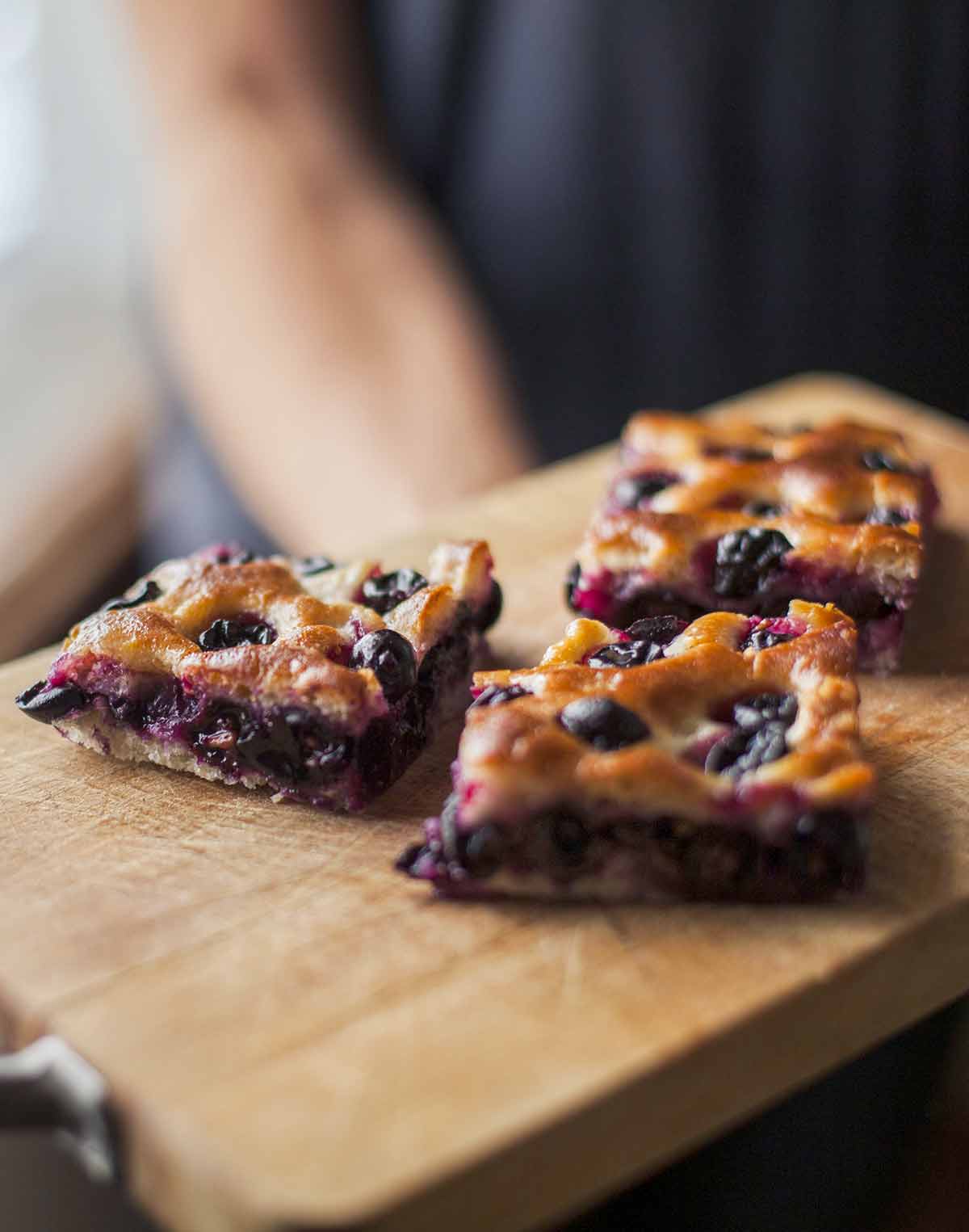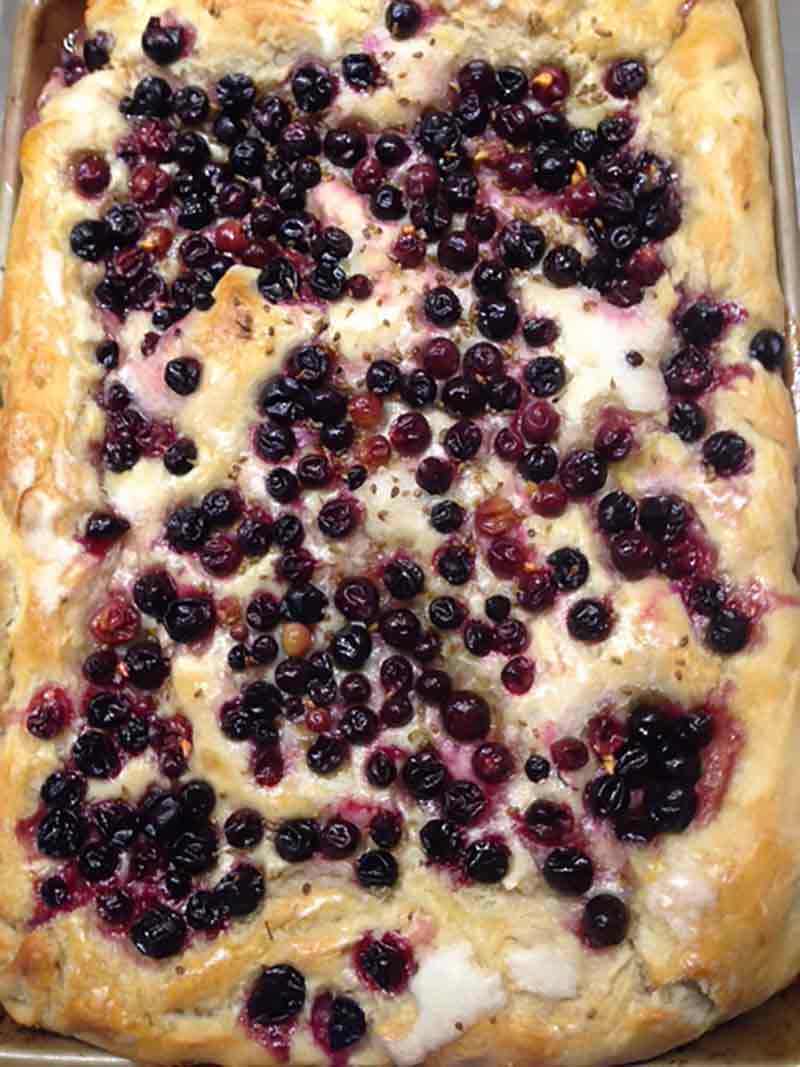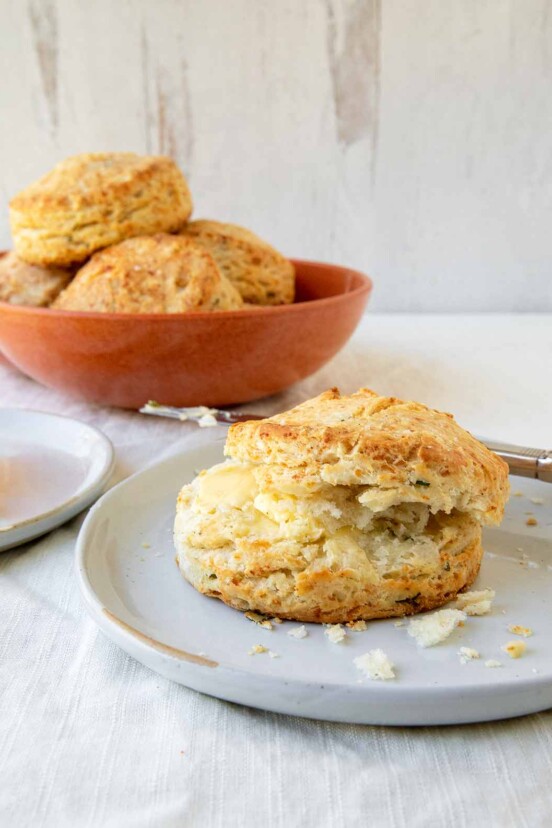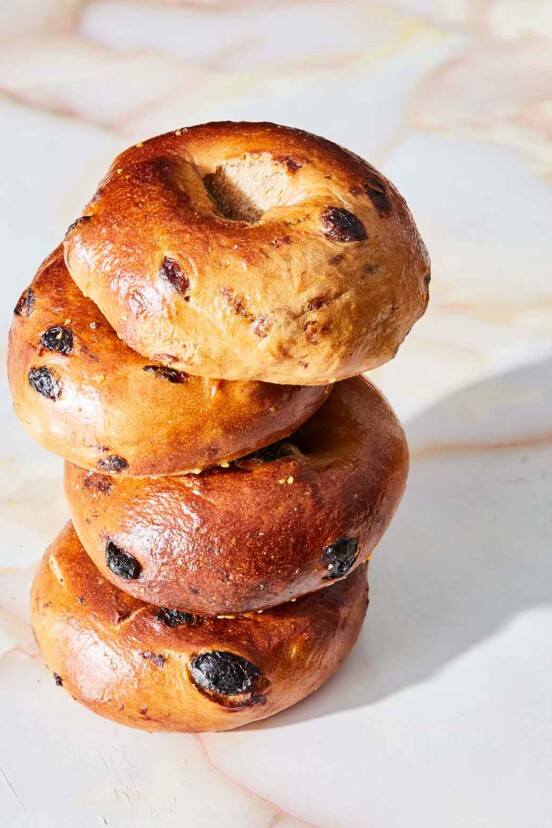
Traditionally, grape focaccia, or Schiacciata All’uva, takes its characteristic jamminess from native Tuscan wine grapes known as canaiolo, the small, dark grapes make up part of the blend of Chianti wine. It’s an Italian winemakers tradition. These days it’s usually made with the more common and fragrant concord grapes (uva fragola). We made it with several varieties of black grapes available in local stores—both those with seeds and without seeds—and everything we tried turned out spectacularly well. Just be warned if you use grapes with seeds, the bread will be punctuated with bitter crunchiness.–Renee Schettler Rossi

Grape Focaccia
Ingredients
For the focaccia dough
- 4 cups all-purpose flour, plus more for dusting
- 2 tablespoons fresh yeast or 1 envelope (2 1/2 level teaspoons or 1/4 ounce or 7 grams) active dry yeast
- 1 2/3 cups lukewarm water
- 5 tablespoons olive oil, plus more for the pan
For the grape focaccia
- 21 ounces concord grapes, (you can substitute another black grape variety, seeded or seedless, but DO NOT try to substitute red or green seedless table grapes)
- 1/3 cup superfine sugar
- Confectioners sugar (optional)
- Coarse sea salt (optional)
Instructions
Make the focaccia dough
- Dump the flour into a large bowl, stir to aerate it, and create a well in the center.
- In a small bowl, dissolve the yeast in about 1/2 cup (4 1/2 ounces | 125 ml) of the lukewarm water.
- Add the yeast mixture to the well in the flour and mix with your hand or a wooden spoon. Add the rest of the water, little by little, working the dough well after each addition to allow the flour to absorb all the water.
- Add 1 tablespoon of the olive oil to the dough and combine. This will form a wet, sticky dough. Rather than knead it, you may need to work it with a wooden spoon or with well-oiled hands for a few minutes until it's smooth.
- Loosely cover the bowl of dough with plastic wrap and set it in a warm place until double in size, about 1 hour. (Alternatively, you can stash the bowl in the fridge and let it rise overnight or until double in size.)
Make the grape focaccia
- Separate the grapes from their stems. Rinse the grapes and pat them dry.
- Preheat the oven to 375°F (190°C).
- Generously slick a 8-inch-by-12-inch (20-cm-by-30-cm) baking sheet or round pizza pan with olive oil. Using well-oiled hands, divide the dough into 2 halves, one slightly larger than the other. Place the larger half onto the oiled pan and, using your fingers, spread the dough out evenly to cover the pan or so that it's no more than 1/2 inch (1.5 cm) thick.
- Place about 2/3 of the grapes on the dough and sprinkle with half the superfine sugar followed by about 2 tablespoons (1 fluid ounce/30 ml) olive oil.
- Stretch the remaining the dough to roughly the size of the pan and place it on the grapes, continuing to stretch it as needed to cover the grapes and dough beneath.
- Roll up the edges of the bottom layer of dough from the underneath to seal the edges. Gently press down all over the surface of the dough to create little dimples. Arrange the rest of the grapes on the dough and evenly sprinkle with the remaining superfine sugar and 3 tablespoons (1 1/2 ounces/45 ml) olive oil.
- Bake until the dough is golden and crunchy and the grapes are oozing, 30 to 35 minutes.
- Let the grape focaccia cool completely. Cut it into squares. (If you like, you can dust it with confectioners sugar or coarse sea salt just before serving—although this isn’t exactly traditional, it is rather nice.) This is best served and eaten the day of baking.
Notes
Grape Focaccia Variation
Aniseed Grape Focaccia There are rarely adaptations made to this traditional recipe, but often you can find the addition of aniseed–a typical Tuscan flavoring for sweets. It’s a good addition, one that brings extra perfume to this bread. When you incorporate half the grapes into the dough, add 1/2 teaspoon aniseed. And when you add the remaining grapes to the surface of the focaccia, sprinkle with another 1/2 teaspoon aniseed prior to dusting with the sugar. Blueberry Focaccia If you can’t get concord grapes or wine grapes, or it’s the wrong season, try replacing them with about 18 oz (500 g) blueberries. It’s completely unorthodox, of course, but it’s a very good substitute, giving you a much closer result than using regular table grapes.
Nutrition
Nutrition information is automatically calculated, so should only be used as an approximation.
Recipe Testers’ Reviews
I was initially a bit skeptical. I love Concord grapes and I love bread, but I wasn’t sure how I would like the two together. After making this grape focaccia recipe, I cannot stop eating it. The grapes in the center melt into a jam-like consistency. This is sweet enough to me to feel like a dessert, but I think that it’s perfect for breakfast.
The most difficult part for me was where it says to stretch out the rest of the dough to roughly the size of the pan. I tried stretching the dough like pizza dough, but the dough kept tearing. I ended up oiling a separate baking sheet and pressing the dough out and gently transferring it on top of the first layer.
I did not use confectioners sugar but it would also look beautiful with a sprinkling of coarse sugar on top for some added sparkle. I plan to try it again with blueberries! Not everyone liked the crunch from the seeds as much as I did, so chew carefully if using grapes with seeds!
Oh my goodness. This grape focaccia was delicious! This recipe is definitely a keeper for me. Very excellent! In my opinion, it’s way better than it sounds. It actually reminded me of a plum cobbler that I’ve had.
I did mine all at once and it took me under 2 hours, so it really is a quick recipe. I know this is totally untraditional, but I think it would have been really good with a dollop of vanilla ice cream right out of the oven. Also, I would love to sway from what is traditional and try it with blueberries, peaches, and a variety of other fruits in place of grapes. You could make it for a nice brunch addition or it seems to work well as a dessert. Either way, give it a try.
This grape focaccia is a completely different take on any idea I had about focaccia and one to make very much in the grape harvest season. I was a little worried that my anise seed (cracked) might be too dominant, so tried it just on the top layer.
That said, I initially I couldn’t find grapes with seeds and made this with the blueberries while I tried to find wine grapes locally. It works beautifully with the blueberries, and I decided I wanted to use whole seeds for my second version.
Nonetheless, it was very tasty and I was encouraged by the result to try again if I could find grapes with seeds. I also wanted to refine my dough handling, by chilling and weighing it to divide the slack dough more easily. I wanted a slightly stronger dough the second time, and also more flavor, which the rye would help with. I also find cold rise doughs much easier to handle and divide.
The very wet dough is delicate and hard to accurately divide unless you weigh it (tare the container used to rise, making note of the weight). The combination of slightly stronger flour and overnight refrigerated rise made a world of difference in handling the dough. The wet dough and your oiled hands make this a lot like shaping a ciabiatta with water on your hands. I also used a dough whisk the second time, having mixed the first batch by hand, and felt it came together much easier and quicker with less handling. I really recommend the overnight dough—it will give anyone more confidence in pressing the dough out. Lastly, it is OK to generously oil the pan. A too thin coating will make it harder to remove it from the pan once cooled.
The second dough was more bread-like and less cakey than the first, which is closer to what you might get with 00 flour.
The surprise for those of us unfamiliar with this sort of traditional focaccia is that the dough has no salt, and in fact there is no salt at all in the recipe. My last refinement the second time was to add a sprinkle of 1/4 teaspoon fine grey sea salt split between the top and inside.
The seeds give you a nice crunch and an even slightly peppery note. This is nice enough that I am going to confidently share it with Italian friends whose cooking I greatly admire.
When a very kind friend and vintner gave us permission to walk their Pinot rows yesterday and we managed to snag enough grapes left orphaned by harvest, I knew I couldn’t pass up the opportunity to try the grape focaccia once again. This recipe really is a 10+ with small wine grapes. I am so glad I had the nerve to ask and that I had access to a really special vineyard.
I let the dough do a slow rise overnight to develop as much flavor as possible. The dough is much easier to handle after the cold bulk rise, and with oiled hands you can easily stretch it out.
This recipe is a keeper—and worth plotting how you will get grapes next season. Next year, I will be begging my vineyard neighbors for grapes! Meanwhile, I know the blueberry version will work year-round.
If you have the time, the effort you put into this is certainly worthwhile, as it produces an amazingly flaky flatbread. I made the dough a day ahead and the schiacciata the next. I did use a pizza stone instead of a baker’s peel and that worked well for me.
The flavor is very good.
The dough is very wet and after mixing it for the 11 minutes, I added more flour. I think that this recipe may depend on the weather because it’s very wet and snowing here. So, that may have affected the formula. I think that if you know how the dough should feel and how to adjust, it’s a good recipe because the flavor is good. I do think that experience with other bread recipes first might help you know how to handle this dough.
















